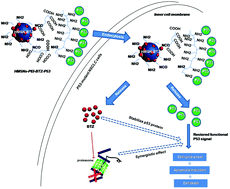Combined bortezomib-based chemotherapy and p53 gene therapy using hollow mesoporous silica nanospheres for p53 mutant non-small cell lung cancer treatment
Abstract
Our previous work reported the development of a proteasome inhibitor, bortezomib (BTZ) encapsulated hollow mesoporous silica nanospheres (HMSNs), as a biocompatible and effective drug-delivery system for non-small cell lung cancer (NSCLC) therapy. Then we found that the tumor-suppressing effect of BTZ or HMSNs-BTZ was compromised in p53 null/mutant NSCLC. In fact, clinical studies have shown a beneficial effect of the combination of p53 gene therapy and chemotherapeutic drugs for patients with NSCLC, especially with the p53 gene null/mutant NSCLC. But there are some safety and toxicity concerns that face the use of gene delivery viral vectors. Here, HMSN-based co-delivery of BTZ and the tumor-suppressor gene p53 was developed for p53 signal impaired NSCLC therapy. The result of the cell viability assay on p53-mutant H1299 cells showed that the half-maximum inhibiting concentration (IC50) of HMSN-PEI-BTZ-p53 was 51% or 25% of that for HMSN-BTZ in 72 or 96 h treatment, respectively. Live/dead staining assay for treated H1299 cells exhibited wider distribution, and higher dead staining was prominent in the HMSNs-PEI-BTZ-p53 group when compared to that of the HMSNs-BTZ group with equivalent BTZ concentration, which was consistent with accumulated p53 expression. Furthermore, the Annexin V-FITC/PI assay suggested restored p53 expression by HMSNs-PEI-BTZ-p53 induced activation of early apoptosis which contributed to enhanced later cell death. Western blotting and real time PCR results showed that several p53 downstream genes responded strongly and synergistically to BTZ function and p53 restored expression (accumulation of p21 and bax, activation of caspase 3, down-regulation of Bcl-2, etc.). Restoration and re-activation of the p53 signal pathway was the basic molecular mechanism for enhanced efficacy of HMSNs-PEI-BTZ-p53 on p53-mutant NSCLC cells.


 Please wait while we load your content...
Please wait while we load your content...